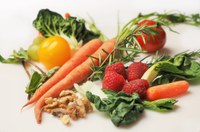Prairie Fare: Maintain your brain health with lifestyle tips
(Click the image below to view a high-resolution image that can be downloaded)
By Julie Garden-Robinson, food and nutrition specialist
NDSU Extension
Most of the time I carry a yellow legal pad wherever I go at work. For some reason, using a white notebook doesn’t work as well for me.
My yellow notebook is a “portable brain” for me. Like everyone else, I have a lot of things to track. I like the immediate visual image on my notepad, even though many electronic systems are available.
I admit that I occasionally add things to my list that I have already finished. Then I mark my “task circle” with an “X.”
That way I have accomplished something on my list.
What we eat affects all aspects of our health, including our heart and our brain. Overall, a heart-healthy diet is a brain-healthy diet.
The greatest risk to our brain is a stroke. Controlling our blood pressure is a key to helping prevent strokes.
To help maintain a healthy blood pressure, moderate your sodium or salt intake and be sure to eat potassium-rich foods, such as plenty of fruits and vegetables. Potatoes and bananas are notable sources of potassium.
Read the Nutrition Facts labels on food products, because potassium content is now listed. Compare sodium content on labels as well.
Some types of fish, such as salmon, trout and albacore tuna, are particularly good sources of omega-3 fats, which our brains need to function. Omega-3 fats are not produced in the body, so we need to get them from our food. We are advised to have two servings of fish or seafood weekly.
Enjoy more nuts and seeds, which contain healthful fats. Some researchers have linked eating more nuts to better brain health with age.
Antioxidant-rich foods also affect our overall health and potentially our brain health. Berries are naturally high in antioxidants, which help protect us from damaging oxidizing chemicals.
Other brightly colored berries, kidney beans, dark chocolate and a variety of fruits and vegetables are good sources of antioxidants too.
Adults and kids often lack green, orange and gold vegetables and fruits in our diet. Use color as a cue. Darker colors, such as dark gold, orange and dark green vegetables and fruits are particularly high in antioxidants. Most adults need at least 4 1/2 cups of fruits and vegetables daily.
Both physical exercise and mental exercises are good for your brain.
You might want to put on your dancing shoes. Dancing is one of the best things you can do for your brain, according to a study published in the New England Journal of Medicine. The researchers followed people ages 75 and older for 21 years to see which activities helped prevent dementia. Frequent dancing was linked with the best protection against dementia of any physical or mental activity they studied.
To exercise our brain, we need to create “new neural paths” instead of repeating what we have always done. Reading, board games and playing musical instruments and other leisure activities also were linked to delaying cognitive decline but not to the degree of protection that dancing provided.
Other tips to improve your memory include:
- Pay attention. Being aware of what is happening increases and exercises your memory. Avoid distractions because interruptions cause us to forget what we were doing.
- Get organized. Take notes because short-term memory can only hold seven items at one time. Choose your seven and jot down notes on the others.
- Use association. Try name-face association. For new information, ask yourself how the information relates to ideas with which you are already familiar. Try familiar stimuli, such as repeating or grouping similar ideas. Example: Remember that your new neighbor Kathy has the same name as your cousin Kathy.
- Remember through teaching. Explain your new memory/idea to others in your own words. This is a great tool for increasing memory.
- Say it out loud. Repeat aloud what you want to remember, recite what you are reading, paraphrase and review notes out loud. Repetition is an effective way to improve memory. Upon meeting a person, use their name as you visit with them.
- Use calendars, day planners, journals, diaries and “to-do” lists. These tools help you remember important dates, appointments and times. Keep them in a place where you are likely to notice them such as on the fridge or your bathroom mirror.
- Use electronic reminders. Try medication systems that buzz, or label or color code boxes and drawers.
- Consider time of day. Consider the optimal time of day for performing mental tasks.
This recipe will feed many guests a colorful and nutritious side dish with your favorite grilled protein such as salmon, chicken or beef. Check out your local farmers market for some fresh produce.
Cowboy Caviar
1/3 cup canola oil or vegetable oil
2 tablespoons sugar
1/3 cup white wine vinegar
1 teaspoon chili powder
1 teaspoon salt
4 cups fresh tomatoes, diced
1 medium red onion, chopped
1 (15-ounce) can chickpeas, drained and rinsed
1 (15 ounce) can black beans, drained and rinsed
1 (10 ounce) bag frozen corn, thawed (or fresh corn cut from cob)
1 cup chopped cilantro (optional)
½ cup diced red bell pepper
½ cup diced green bell pepper
Whisk together olive oil, sugar, white wine vinegar, chili powder and salt in a large bowl. Stir in the remaining ingredients, cover and refrigerate. Serve with chips or crackers.
Makes 12 servings. Each serving has 170 calories, 7 grams (g) fat, 5 g protein, 24 g carbohydrate, 5 g fiber and 300 milligrams sodium.
(Julie Garden-Robinson, Ph.D., R.D., L.R.D., is a North Dakota State University Extension food and nutrition specialist and professor in the Department of Health, Nutrition and Exercise Sciences. Follow her on Twitter @jgardenrobinson)
NDSU Agriculture Communication – July 21, 2022
Source: Julie Garden-Robinson, 701-231-7187, julie.garden-robinson@ndsu.edu
Editor: Elizabeth Cronin, 701-231-5391, elizabeth.cronin@ndsu.edu


